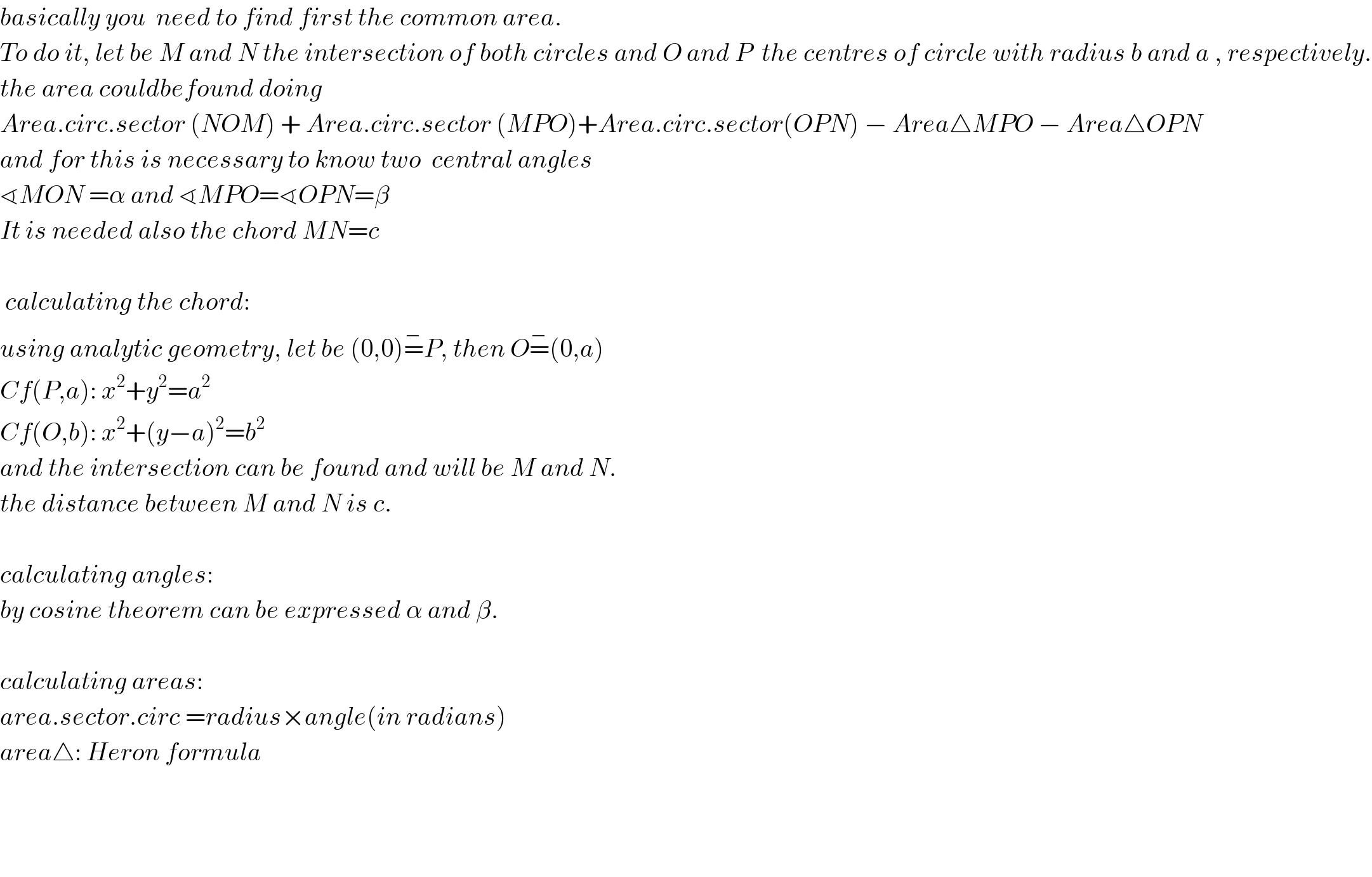
Question Number 6334 by sanusihammed last updated on 24/Jun/16

Commented by nburiburu last updated on 24/Jun/16

$${basically}\:{you}\:\:{need}\:{to}\:{find}\:{first}\:{the}\:{common}\:{area}. \\ $$$${To}\:{do}\:{it},\:{let}\:{be}\:{M}\:{and}\:{N}\:{the}\:{intersection}\:{of}\:{both}\:{circles}\:{and}\:{O}\:{and}\:{P}\:\:{the}\:{centres}\:{of}\:{circle}\:{with}\:{radius}\:{b}\:{and}\:{a}\:,\:{respectively}. \\ $$$${the}\:{area}\:{couldbefound}\:{doing} \\ $$$${Area}.{circ}.{sector}\:\left({NOM}\right)\:+\:{Area}.{circ}.{sector}\:\left({MPO}\right)+{Area}.{circ}.{sector}\left({OPN}\right)\:−\:{Area}\bigtriangleup{MPO}\:−\:{Area}\bigtriangleup{OPN} \\ $$$${and}\:{for}\:{this}\:{is}\:{necessary}\:{to}\:{know}\:{two}\:\:{central}\:{angles} \\ $$$$\sphericalangle{MON}\:=\alpha\:{and}\:\sphericalangle{MPO}=\sphericalangle{OPN}=\beta \\ $$$${It}\:{is}\:{needed}\:{also}\:{the}\:{chord}\:{MN}={c} \\ $$$$ \\ $$$$\:{calculating}\:{the}\:{chord}: \\ $$$${using}\:{analytic}\:{geometry},\:{let}\:{be}\:\left(\mathrm{0},\mathrm{0}\right)\overset{−} {=}{P},\:{then}\:{O}\overset{−} {=}\left(\mathrm{0},{a}\right) \\ $$$${Cf}\left({P},{a}\right):\:{x}^{\mathrm{2}} +{y}^{\mathrm{2}} ={a}^{\mathrm{2}} \\ $$$${Cf}\left({O},{b}\right):\:{x}^{\mathrm{2}} +\left({y}−{a}\right)^{\mathrm{2}} ={b}^{\mathrm{2}} \\ $$$${and}\:{the}\:{intersection}\:{can}\:{be}\:{found}\:{and}\:{will}\:{be}\:{M}\:{and}\:{N}. \\ $$$${the}\:{distance}\:{between}\:{M}\:{and}\:{N}\:{is}\:{c}. \\ $$$$ \\ $$$${calculating}\:{angles}: \\ $$$${by}\:{cosine}\:{theorem}\:{can}\:{be}\:{expressed}\:\alpha\:{and}\:\beta. \\ $$$$ \\ $$$${calculating}\:{areas}:\: \\ $$$${area}.{sector}.{circ}\:={radius}×{angle}\left({in}\:{radians}\right) \\ $$$${area}\bigtriangleup:\:{Heron}\:{formula} \\ $$$$ \\ $$$$ \\ $$$$ \\ $$
Commented by sanusihammed last updated on 25/Jun/16

$${Thanks}\:{so}\:{much} \\ $$
